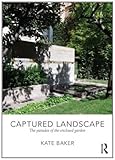Captured landscape : the paradox of the enclosed garden / Kate Baker.
Material type: TextPublication details: London ; New York : Routledge, 2012.Description: viii, 209 pages : illustrations (chiefly color) ; 26 cmISBN:
TextPublication details: London ; New York : Routledge, 2012.Description: viii, 209 pages : illustrations (chiefly color) ; 26 cmISBN: - 9780415562287 (hbk.)
- 0415562287 (hbk.)
- 9780415562294 (pbk.)
- 0415562295 (pbk.)
- The paradox of the enclosed garden
- SB472.45 .B35 2012
| Item type | Current library | Call number | Status | Date due | Barcode | Item holds | |
|---|---|---|---|---|---|---|---|
| Lending Books | Elisabeth C. Miller Library Tall Shelves | SB472 .B25 2012 (Browse shelf(Opens below)) | Available | 39352800147886 |
Browsing Elisabeth C. Miller Library shelves, Shelving location: Tall Shelves Close shelf browser (Hides shelf browser)

|

|

|

|

|

|

|
||
| SB472 .A54 2017 The essential garden design workbook / | SB472 .A87 1983 The Yearbook of landscape architecture : historic preservation / | SB472 .B25 2010 A landscape manifesto / | SB472 .B25 2012 Captured landscape : the paradox of the enclosed garden / | SB472 .B42 1998 Earthworks and beyond : contemporary art in the landscape / | SB472 .B48 2001 Revelatory landscapes / | SB472 .B55 2000 New classic gardens / |
Includes bibliographical references (pages 195-198) and index.
Defining the territory : the ambiguous nature of an enclosed garden -- From patio to park: the enclosed garden as a generator of architectural and landscape design -- Taming nature -- and the way to paradise -- Ritual and emptiness -- and the rigour of developing an idea -- Sensory seclusion : the affective garden, the garden room as a scene for living -- Detachment : the separation of the garden from the building.
The enclosed garden, or hortus conclusus, is a place where architecture, architectural elements, and landscape, come together. It has a long history, ranging from the paradise garden and cloister, the botanic garden and the giardini segreto, the kitchen garden and the stage for social display, to its many modern forms; the city retreat, the redemptive garden, and the deconstructed building. By its nature it is ambiguous. Is it an outdoor room, or captured landscape; is it garden or architecture? Kate Baker discusses the continuing relevance of the typology of the enclosed garden to contemporary architects by exploring influential historical examples alongside some of the best of contemporary designs -- brought to life with vivid photography and detailed drawings -- taken mainly from Britain, the Mediterranean, Japan and South America. She argues that understanding the potential of the enclosed garden requires us to think of it as both a design and an experience. As climate change becomes an increasingly important component of architectural planning, the enclosed garden, which can mediate so effectively between interior and exterior, provides opportunities for sustainable design and closer contact with the natural landscape. Study of the evolution of enclosed gardens, and the concepts they generate, is a highly effective means for students to learn about the design requirements of outdoor space proximal to the built environment. Captured Landscape provides architectural design undergraduates, and practising architects, with a broad range of information and design possibilities. It will also appeal to landscape architects, horticulturalists and a wider audience of all those who are interested in garden design.
